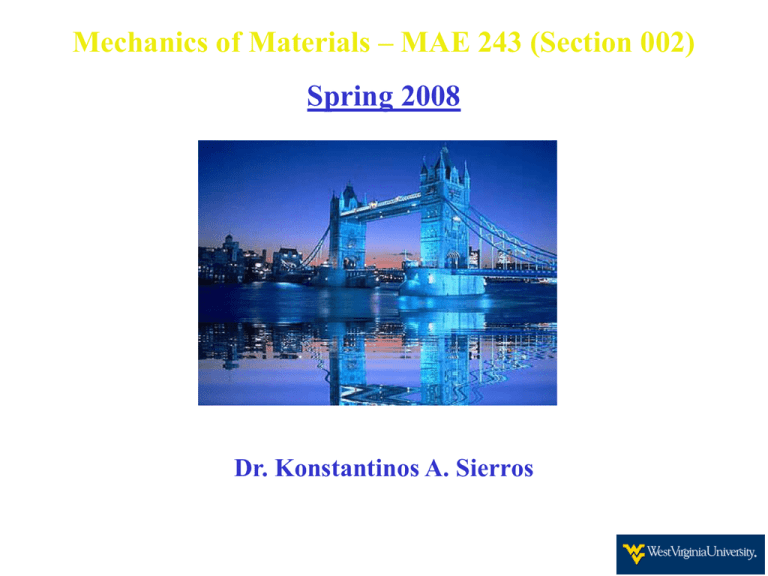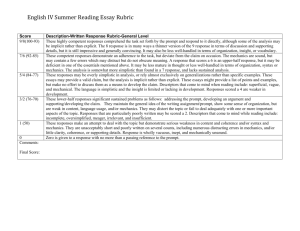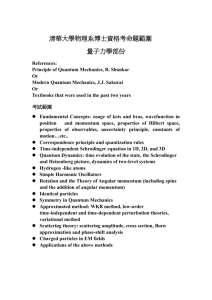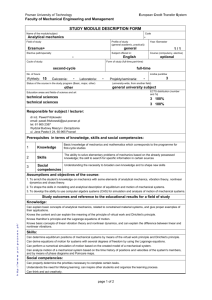Lecture 1
advertisement

Mechanics of Materials – MAE 243 (Section 002) Spring 2008 Dr. Konstantinos A. Sierros General info • M, W, F 8:00-8:50 A.M. at Room G-83 ESB • Office: Room G-19 ESB • E-mail: kostas.sierros@mail.wvu.edu • Tel: 304-293-3111 ext.2310 •Course notes: http://www.mae.wvu.edu/~cairns/teaching.html USER NAME: cairns PASSWORD: materials • Facebook : Konstantinos Sierros (using courses: Mechanics of Materials) • Office hours: M, W 9:00-10:30 A.M. or by appointment Course textbook Mechanics of Materials, 6th edition, James M. Gere, Thomson, Brooks/Cole, 2006 Why do we study Mechanics of Materials? Anyone concerned with the strength and physical performance of natural/man-made structures should study Mechanics of Materials Why do we study Mechanics of Materials? SAFETY and COST !! Structural integrity of materials is important… 1.1: Introduction to Mechanics of Materials Definition: Mechanics of materials is a branch of applied mechanics that deals with the behaviour of solid bodies subjected to various types of loading Compression Tension (stretched) Bending Torsion (twisted) Shearing 1.1: Introduction to Mechanics of Materials Fundamental concepts • stress and strain • deformation and displacement • elasticity and inelasticity • load-carrying capacity Design and analysis of mechanical and structural systems 1.1: Introduction to Mechanics of Materials • Examination of stresses and strains inside real bodies of finite dimensions that deform under loads • In order to determine stresses and strains we use: 1. Physical properties of materials 2. Theoretical laws and concepts Problem solving • Draw the free-body diagram • Check your diagram • Calculate the unknowns • Check your working • Compute the problem • Check your working • Write the solution • Check your working Free body diagrams I Free body diagrams II Statics example 4 3 2m 200kN A steel beam with a tensile strength of 700 MPA is loaded as shown. Assuming that the beam is made from hollow square tubing with the dimensions shown will the loading in the x direction exceed the failure stress? 0.01m 0.02m Step 1: Free body diagram 4 3 2m 240kN.m 200kN 120N 160kN 160kN 120kN Step 2: Calculate moment of inertia I=1/12 x (0.024)- 1/12 x (0.014) m4 =1.25 x 10-8 m4 A=0.022-0.012 m2 =0.0003 m2 0.01m 0.02m Step 3: Shear and moment diagrams 4 3 V 2m 120 200kN x M x -240 Step 4: Calculation of maximum tensile stress • Stress due to axial loading axial F 160 kPa 533 .33MPa A 0.0003 • Stress due to bending bend Mc 240 0.01 kPa 1920 MPa 8 I 1.25 10 ANS: Total stress greater than failure stress therefore failure will occur Key to success Ask questions and seek help if you feel like it!!!











